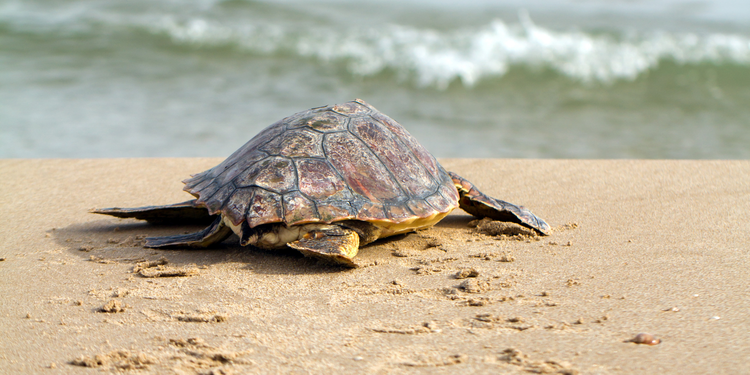
It’s March and that means one thing, it’s sea turtle nesting season on the Space Coast. March 1 marks the beginning of the seven month long nesting season on Florida’s Atlantic coast where three different species of the endangered sea turtle will crawl up the beaches to lay their eggs. Florida alone is home to 90% of all sea turtle nests laid in the United States each year with the Space Coast's seventy two mile coastline being one of the largest nesting sites for loggerhead sea turtles in the world.
What do sea turtles eat and when do they arrive?
The first to the beach are the colossal leatherback sea turtles. One of the largest reptiles on earth, leatherback turtles can reach up to eight feet long and weigh on average one thousand pounds. These lumbering giants make their way up the sand to begin nesting in March.
Later in April, loggerhead sea turtles make their way onto our beaches to nest. Known as a “keystone species," many animals in the ocean depend on loggerhead turtles for their survival. With the diet of the loggerhead being mainly invertebrates, the shells of their food pass through and end up on the bottom of the ocean where it is eaten as a calcium source sustaining other marine life.
Lastly, the green sea turtles come around May and June. Green sea turtles are known for being one of the only species of sea turtle that has a vegetarian diet which scientists believe leads to the layer of quirky green colored fat that gives them the moniker the green sea turtle.
After laying a nest and returning to the sea, the sea turtle’s eggs will spend around fifty to sixty days incubating. After the incubation period, the hatchlings will crawl their way out of the nest and make a mad dash for the water. It is estimated only 1 in 1,000 hatchlings will reach adulthood because of the vast amount of predation towards them from animals and humans.
Sea turtles were declared endangered in 1973 after years of over harvesting them for their meat, eggs, leather and tortoise shells. With overdevelopment of nesting habitats along coastlines, sea turtles have been fighting an uphill battle to make a comeback. Luckily, there’s a few easy ways we can all help with sea turtle conservation.
Leave No Trace
One of the best ways to spend a Saturday is a day at the beach. However those holes you dug and sandcastles you built can become hazards for sea turtles and disrupt them from reaching their nesting site. Being thoughtful to fill in holes and flatten sandcastles before leaving the beach ensures nesting mothers a clear path to nest and hatchlings a clear path to the water.
Lights Out After Dark
Studies show artificial lighting on beaches from houses, businesses, flashlights and cell phones reduces the nesting success by 20%. Artificial lighting discourages females from nesting and often ends in false crawls. After several false crawls females will resort to less optimal nesting spots or deposit her eggs in the ocean. Lighting can also negatively impact hatchlings who become disoriented and wander inland, away from the ocean where they often fall victim to predation or dehydration. This also applies to bonfires. Beach bonfires are not allowed during nesting season due to the light put off by the fire and the heat from the fire. The heat from a fire built on or near an incubating nest destroys the nest. Lights out after dark are taken so seriously in Florida that Brevard County filed an ordinance that prohibits any visible light on beaches from May 1st through October 31st.
Go With A Guide
While sea turtle tourism is quite popular and an amazing experience to share, it is important that it is done respectfully and with care to not disturb the turtles. The best way to see nesting sea turtles and not disturb them is to go on a tour, or turtle walk, with the Sea Turtle Preservation Society. The Sea Turtle Preservation Society regularly takes groups on their turtle walk to see nesting loggerheads near the Archie Carr national Wildlife Refuge, the second largest loggerhead nesting area in the world. Reservations must be made ahead of time with walks departing several nights a week during May, June, and July.
Sea Turtles play a vital role in marine ecosystems through maintaining healthy seagrass beds and reefs that provide vital habitat for other species as well as balancing marine food webs facilitating the nutrient cycle. By following a few simple guidelines and going with professionals to experience sea turtles, we can all play a role in helping these magnificent creatures flourish once again.
